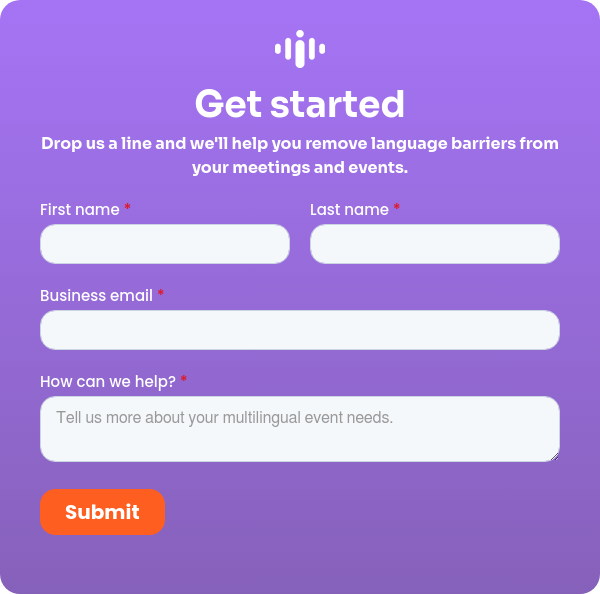The COVID-19 pandemic forced event planners to shift to virtual events in March 2020. While this was an unexpected challenge, many event organisers found great success with virtual events and embraced the benefits that the virtual world brought to their events.
However, as in-person events are gradually coming back, event organisers are looking for ways to blend the best qualities of virtual event platforms with traditional venue-based events. By offering attendees both in-person and online options, event planners can make their events more flexible and accessible to a larger global audience. In this article, we explore what hybrid events are, their benefits, examples, and how to organise one.
So, what is a hybrid event?
A hybrid event is an event that combines in-person and online elements. It includes both: a live experience at a physical venue, which speakers and attendees can join in person, and a virtual experience hosted online where speakers and attendees can participate remotely, usually on an event platform.
At the core of a hybrid event is a conference, trade show, seminar, workshop or another meeting type that combines an in-person "live" event experience with a "virtual" online component.
There are three key components that make an event hybrid:
- Two experiences - The event has both in-person and online elements.
- Cross-channel engagement - All attendees (both in-person and online) can interact with each other and with presenters.
- Live - The event is at least partly live.
Are hybrid events a new thing?
No, the concept of combining virtual and on-site is not something new. Historically, most hybrid events were just in-person events streamed live for an online audience watching from home.
Long before Covid-19, Interprefy supported event planners with hybrid setups, bringing live translation from remote interpreters to on-site and often also remote attendees and delegates.
Covid-19 is certainly a catalyst in the recent boom of virtual events, but by no means created a completely new event format.
While they’re nothing new, hybrid events have become top-of-mind as the Covid-19 pandemic changed how the world lived and conducted business. Today's hybrid events go beyond a live stream and aim to engage both virtual and in-person audiences through technology fully - in the form of chats, networking, and often elaborate installations in the venue to connect people on both sides of the screen.
Ultimately, today we're seeing hybrid events continuing to evolve and close the gap between the experiences that on-premise and virtual audiences have.
Benefits of hybrid events
Combining the best qualities of traditional events and virtual events can bring a number of benefits both for your attendees and for your organisation:
- Event reach- Attendees who may not be able to travel to your event are now provided the option to attend virtually, meaning you can open the floodgates to a large global audience.
- Unlock audience engagement potential - Turn spectators into engaged participants by utilising cutting-edge engagement features that virtual event platforms provide.
- Expand accessibility and inclusivity - No longer is attendance limited to those with the resources and physical abilities to travel to the venue.
- Get more event data and audience insights - Sophisticated virtual event platforms and apps provide deeper insight into attendance and engagement.
- Improve your carbon footprint - Traditional events contribute to large emissions - from travel to accommodation and material waste. The shift to virtual has positively impacted the industry's emissions, and by continuing to adapt virtual components, event planners can bring down their carbon emissions.
- Stay agile and prepare for the unexpected - Event planners cannot plan for possible disruptions but by not just bolting on virtual, but catering equally to two experiences, the risk of cancellation can be mitigated.
Get more insights into the benefits of hybrid events in our blog post on unlocking the full potential of hybrid events.
Hybrid event examples
Hybrid events can take on many shapes. In its simplest forms, a hybrid event will add an online layer to a physical, in-person event - in order to reach and engage a broader audience without the need for them to travel to participate.
A few examples of hybrid events could be:
- A large trade show at an exhibition venue, with exclusive online content and an event app used by both on-site and virtual visitors
- A live-streamed annual summit at a theatre presented to a limited audience and broadcast to millions of people online
- An international conference at a convention centre with some speakers at the venue and others connected via web conferencing, broadcast to in-person attendees on a large screen
Types of hybrid events
Most common types of meetings and events can adapt hybrid aspects, even internal company events.
Consider how these types of events could work in a hybrid setting for your organisation:
- Team meetings
- Trade shows
- Webinars
- Product launches
- Townhall meetings
- Conferences
- Training seminars
- Annual kick-off meetings
What does a hybrid event look like?
With hybrid events, attendees have the option to either attend or, if they are unable to travel on-site or simply prefer to connect remotely, participate online. Event planners utilise sophisticated virtual event platforms to complement the in-person experience.
Hybrid events could simply stream their program online, risking that virtual attendees may feel left out. To engage their audience, many event planners use event technology that provides engagement features.
Possible engagement features include:
- Live polls
- Virtual Q&As
- Activity feeds
- Networking sessions
- Matchmaking software
- Live language interpretation
- Breakout rooms
- Event chats
Learn more about how you can make your hybrid event a success with Interprefy's Ultimate Guide To Multilingual Virtual & Hybrid Event Planning
Getting started
1. Put your audiences first
The first thing to keep in mind when getting started with hybrid events is that they present a balancing act between on-site and virtual visitors, whose experiences should be harmonised - creating an event with two experiences. The challenge is to make sure your content works for both groups, while it doesn't feel like two completely different events.
So a good starting point is to focus on your audiences: who are they, what are they expecting, what value can you add to their experience, how can you keep their attention and engagement hight and how can you add a positive element of surprise?
2. Set SMART goals
Define the business goals that your event supports and how your can set SMART goals for your event. Which virtual aspects could support those goals and how can you measure their impact?
3. Define your program wisely
When defining your program and schedule, consider attention span and timezones. Choose quality over quantity, as your virtual audience may be connecting from a bustling coffee shop or the family home.
4. Work with a top-notch AV partner to create an immersive experience
To create a compelling event experience on both sides of the venue, it's absolutely key to work with a top-notch AV and production partner. Don't risk your event looking like a bad Zoom call. High-quality cameras, audio equipment and the expertise of your AV partner will ultimately determine the success of your hybrid event.
5. Choose your tech stack wisely
Research and select a virtual or hybrid event platform that can support your needs from registration all the way to engaging your virtual and live audiences through a desktop and mobile app.
Because your audience can now connect from anywhere in the world, make sure everyone can understand and your presenters can be understood by anyone. Selecting an Interprefy platform partner means you can provide your attendees with live language translation - both on-site through the Interprefy mobile app and within the event platform for those connecting remotely.
The right multilingual event technology partner will also offer a range of language access solutions, ranging from professional interpretation by trained interpreters or AI-powered solutions such as live captions and AI speech translation. Ensure your chosen technology partner can connect with your preferred event platform and provide project management and remote support for extra peace of mind.






.webp?width=468&quality=high)



 More download links
More download links



